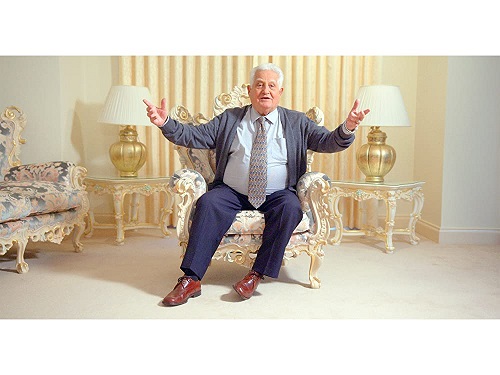
PALAZZO DI COZZO
Australia, 2021, 85 minutes, Colour.
Directed by Madaleine Martiniello.
Franco Cozzo is a Melbourne icon, a self-made man, seller of furniture over many decades, furniture in the baroque style. Clearly, this is a film for Melbourne, for Melbournites who are not as young as they used to be and who remember the flamboyant salesman from his television commercials. They may have forgotten a lot of the detail, but this documentary will revive the memories.
But, Palazzo Di Cozzo is not a documentary simply for the inhabitants of Melbourne. It is extremely relevant for Australians. And it offers much of interest to international audiences.
The reason for saying this is that Franco Cozzo’s story is almost an archetypal migrant story, from any culture to any other culture, difficult beginnings, determination and enterprise, success. And, since so many migrants came from Italy to Australia (as they formerly did to the United States), this is the study of the meaning of migration, the implications for what it was for the migrants to adapt to their new country.
While Franco Cozzo, 83 at the time of making the film, 85 at the time of its release, is certainly at the centre, self-promotion was definitely his forte, enjoyably so for himself and for the public, there are also quite a number of talking heads discussing the immigration issues.
There are photos and footage from the past. And the filmmakers have been very diligent in finding a great deal of film material from the 40s and 50s illustrating the arrival of migrants, their initial jobs, community support… And, this kind of footage is very creatively used in a significant part of the film where one of Cozzo’s sons goes to prison for drug dealing and word goes round, suspicious of Cozzo himself and involvement in drugs. There is a visual collage, extensive, illustrating whispering, gossip, suspicions, accusations.
But, Franco Cozzo himself has sailed through life, marriage and children, separation and divorce, second marriage and children, an extraordinary success in business. In fact, the film includes visits to several homes, visual tours of houses to look at the furniture in situ.
But, we all, this reviewer included, remember the commercials. And they are repeated here – though initially he seems to be able to pronounce Footscray accurately enough but as time went on, there was the inserted that vowel sound (this reviewer remembering it as Foot-a-scray), seen on screen now many times as Footisgrai. Franco Cozzo so relished the Ads in Italian, even extending some of them into Greek. And there was the continual reminder, genially urgent, “Grand Sale”. And there he was on television shows, being interviewed by Don Lane and dramatising his sales pitch, his daughter appearing on Young Talent Time and a callout from Johnny Young, newsreaders to giving stories about him, like Mike Willesee.
So, while there is plenty of footage from the past, there is also plenty of footage of the man himself aged 80, still full of life, contemplating selling his Footisgrai store, discussions with agents, his changing his mind, reviewing all the furniture that is still there and probably unsellable (although there are some sequences with incoming Asian and African potential clients).
So, Australia has been called the lucky country – and, for Franco, for this migrant from Sicily, bringing out his parents, starting from scratch, Australia was lucky (but we must never underestimate Franco Cozzo and his business shrewdness, ingenuity, boundless energy).